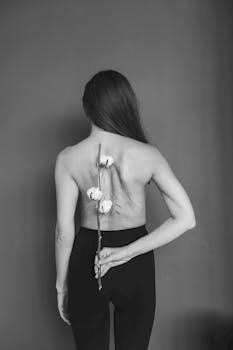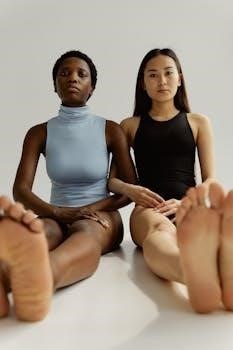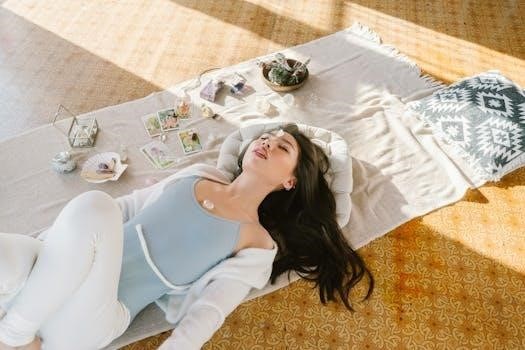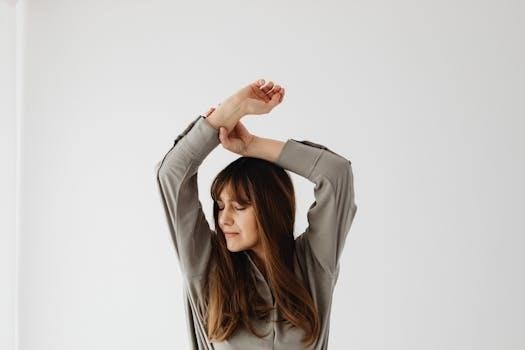
gentle yoga sequence pdf
Gentle Yoga Sequence Overview
Gentle yoga is a practice involving a gradual flow into deeper stretches, making it suitable for various levels, including beginners. Sequences can be modified for chair or sofa use, enhancing accessibility. These sequences are designed to promote relaxation, improve circulation, and reduce stress, offering a way to connect deeply with body and mind.
Gentle yoga provides a modified approach to traditional yoga, prioritizing relaxation and accessibility. It is characterized by slow, deliberate movements and poses that are less strenuous, making it an ideal practice for individuals of varying fitness levels, including older adults or those with physical limitations. Unlike more vigorous forms of yoga, gentle yoga focuses on connecting the mind and body through gentle stretching, breathing exercises, and mindfulness. This form of yoga uses modifications, such as chair or sofa assistance, to ensure that poses are achievable and comfortable for all. The emphasis is on fostering a sense of calmness and well-being rather than pushing the body to its limits. Gentle yoga is designed to reduce stress, improve circulation, and increase flexibility gradually, helping individuals cultivate a deeper connection with their bodies and promoting overall health. It’s about finding comfort and relief through mindful movement and gentle stretches. This practice encourages practitioners to listen to their bodies and adapt poses as needed, ensuring a safe and enjoyable experience that promotes both physical and mental well-being. The gentle nature of this practice makes it a valuable tool for anyone seeking relaxation and mindful movement.
Benefits of Gentle Yoga
Gentle yoga offers a multitude of benefits, making it a valuable practice for many. This approach promotes increased flexibility and mobility through gentle stretching, helping to ease stiff muscles and joints. It is particularly effective in reducing stress and promoting relaxation, thanks to its focus on mindful movement and breathing techniques. Gentle yoga can significantly improve circulation, supporting cardiovascular health and overall well-being. It is also a great option for those with physical limitations or older adults, as it can be adapted to chair or sofa support, making it accessible to all. The practice encourages a deeper connection with the body, fostering self-awareness and promoting mental clarity. Moreover, gentle yoga helps in managing pain, especially in the lower back and other areas prone to tension. The calming nature of the practice is beneficial for those seeking relief from anxiety and promoting a sense of inner peace. Regular gentle yoga sessions can also lead to enhanced sleep quality and improved posture. Ultimately, this type of yoga supports overall health by gently nurturing the body and mind. It provides a safe and effective way to enhance physical and emotional well-being.

Types of Gentle Yoga Sequences
Gentle yoga sequences vary, encompassing chair modifications for those with mobility issues, restorative practices focused on deep relaxation, and slow flow styles that emphasize mindful movement. These different approaches cater to diverse needs and preferences, providing accessible options for everyone.
Chair Yoga Modifications
Chair yoga modifications adapt traditional poses for seated practice, using a chair or sofa to support those who find it difficult to stand or move easily between positions. This approach, often called couch yoga, makes the benefits of yoga accessible to older adults and individuals with mobility limitations. By remaining seated, practitioners can safely loosen muscles, reduce stress, and enhance circulation. Chair yoga allows for a range of exercises, from gentle stretches to mindful breathing techniques. These modifications can include seated mountain pose, forward folds, and twists, all performed while maintaining support from the chair. The focus is on adapting poses to ensure comfort and safety, enabling everyone to experience the positive effects of yoga, regardless of physical ability. This form of yoga also helps to build confidence and encourages a sense of well-being through accessible and gentle movements. The seated position facilitates deeper relaxation and improved focus, which are often sought-after benefits of yoga practices.
Restorative Gentle Yoga

Restorative gentle yoga focuses on active relaxation, using props like bolsters to support the body in comfortable positions, promoting deep relaxation and stress relief. Restorative sequences often involve fewer poses, held for longer periods, encouraging the body to release tension and find a sense of calm. Unlike more active forms of yoga, restorative practices aim to soothe the nervous system, allowing for a gentle unwinding of both mind and body. These sequences can incorporate poses done on the back with knees bent and feet flat on the floor, promoting a sense of groundedness. The goal is to create a space for the body to naturally release, without strain. Restorative yoga is particularly helpful for those feeling overwhelmed or fatigued, providing an opportunity to recharge and restore energy levels. The use of props ensures that each pose is fully supported, allowing the individual to simply be and let go. This practice is all about finding comfort and relief, making it a valuable tool for overall well-being and stress reduction.

Slow Flow Gentle Yoga
Slow flow gentle yoga emphasizes a mindful connection between movement and breath, linking poses together in a smooth, unhurried manner. This style encourages students to move with intention, paying close attention to their body’s sensations, rather than rushing through postures. Unlike faster-paced vinyasa styles, slow flow allows for a deeper exploration of each pose, promoting flexibility and body awareness. The practice often involves sequences that are designed to gently open the body, incorporating twists and chest openers, which can help to release tension and improve mobility. The slower pace provides an opportunity for practitioners to connect more deeply with their inner experience, fostering a sense of calm and presence. Slow flow gentle yoga is particularly beneficial for those seeking a more meditative approach to movement, allowing for a greater sense of relaxation and well-being. This practice is suitable for different levels, making yoga accessible to a wider range of people who desire a gentler approach.

Gentle Yoga Sequence Elements
Gentle yoga sequences incorporate warm-up poses, specific gentle poses, and relaxation techniques. Warm-ups prepare the body for movement, while gentle poses focus on stretching and mindfulness. Relaxation techniques at the end help to restore and calm the body and mind.
Warm-up Poses
Warm-up poses in a gentle yoga sequence are crucial for preparing the body for deeper stretches and movements. These poses are designed to be gentle and accessible, focusing on increasing circulation and warming up the muscles and joints. A typical gentle yoga warm-up might include seated stretches, such as gentle neck rotations, shoulder rolls, and arm stretches. These movements help to loosen tension and promote flexibility. Another common warm-up is gentle spinal twists done while seated, which increase mobility in the back and hips. Simple cat-cow stretches can be done while seated or on hands and knees to improve spinal flexibility and wake up the core muscles. Breath awareness is also incorporated into the warm-up, guiding movements to ensure they are done with control and ease. Gentle leg stretches, like ankle rotations and leg lifts, can further prepare the body for a gentle yoga practice. These warm-up poses ease any stiffness, making the body more receptive to the practice.
Specific Gentle Poses
Specific gentle poses are the heart of a gentle yoga sequence, designed to be accessible and beneficial for all levels. These poses are often held for a longer duration, promoting deeper relaxation and stretching. Seated poses, such as easy pose (Sukhasana) and seated forward fold (Paschimottanasana), help to stretch the spine and hamstrings. Modified versions of standing poses like mountain pose (Tadasana) with support or chair support, and gentle side stretches are incorporated to improve balance and flexibility without strain. Gentle twists like seated spinal twist (Ardha Matsyendrasana) are used to release tension in the back and increase mobility. Child’s pose (Bālāsana) offers a comforting and restorative option, allowing for deep relaxation. Supported bridge pose (Setu Bandhasana) using a bolster or blocks is included to gently open the chest and shoulders. Savasana, or corpse pose, is usually done at the end of the session for deep rest and restoration. These gentle poses ensure a safe and effective practice for all.
Relaxation Techniques
Relaxation techniques are an essential component of a gentle yoga sequence, aiming to soothe the mind and body, and enhance the overall benefits of the practice. These techniques often involve a combination of guided visualizations, breathwork, and mindfulness. Deep, slow breathing exercises, such as diaphragmatic breathing, are used to calm the nervous system and reduce stress. Body scans, where you bring awareness to different parts of the body, help release tension and promote a sense of grounding. Progressive muscle relaxation, involving tensing and releasing different muscle groups, assists in letting go of physical tightness. Guided meditations, which may include visualizations of peaceful scenes or positive affirmations, are incorporated to quiet the mind and foster a sense of inner peace. Restorative poses, often supported by props like bolsters and blankets, allow the body to fully relax into a state of comfort. The practice of Savasana, a final resting pose, is emphasized as a time for complete surrender and relaxation. These techniques help to integrate the benefits of the physical practice into a state of mental and emotional calm.